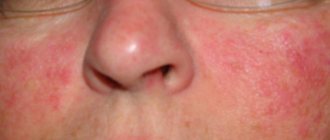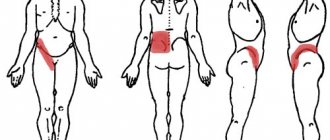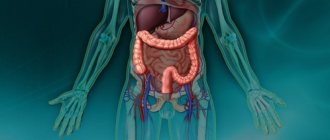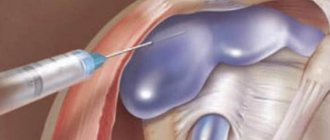Abdominal pain in the navel area signals a problem in the human body. The causes of the pathological process can be judged by the intensity and irradiation of discomfort. Gastroenterologists warn that you should not neglect a visit to the doctor even with mild pain. It often indicates the development of diseases of the gastrointestinal tract, kidney problems, and the incubation period of dangerous intestinal infections. A timely visit to a hospital will allow you to begin treatment immediately and avoid serious complications. In some cases, this helps save a person's life.
Abdominal pain in the navel area is a good reason to visit a gastroenterologist
The most likely causes of pain
The most likely cause of pain near the navel is a developing process in the small intestine. A decrease in the functional activity of its middle part provokes a violation of the absorption of nutrients and biologically active substances, which negatively affects human health. The cause of discomfort can be diseases of the organs located in the immediate vicinity of the navel:
- ureters;
- kidneys;
- stomach;
- small intestine.
Considering that all internal organs are characterized by numerous diseases, it is not possible to independently determine the pathology. But an experienced diagnostician will use this rather specific symptom to suggest the most likely causes of the pain syndrome. These include:
- acute forms of narrowing of the lumen of the middle section of the small intestine;
- circulatory disorders in the mesenteric vessels that supply blood to the jejunum, acute and chronic forms;
- inflammatory processes in the middle section of the small intestine;
- congenital or acquired umbilical hernia, characterized by pain as a result of stress or strangulation;
- enzyme deficiency, causing digestive disorders in the small intestine;
- benign or malignant neoplasms in the intestine;
- enterocolitis, usually accompanied by painful spasms;
- viral or bacterial intestinal infections;
- irritable bowel syndrome, which causes pathological changes in intestinal motor activity of functional etiology.
Each of the above diseases is characterized by its own clinical picture, which includes pain in the navel area. When contacting a doctor, it is necessary to tell about all the recent changes in the functioning of the body. This will speed up the diagnosis and allow you to quickly draw up a therapeutic regimen.
Aching, nagging pain near the navel, sharp, stabbing pain near the navel, causes
Around the navel there are several organs belonging to different systems, deviations in the functioning of which cause pain. Abdominal pain can be true and radiating, that is, displaced from the source of the disease located in another part of the abdomen.
Every disease has its own specific abdominal pain. Their varieties will be discussed below.
1 Aching pain in the abdomen in the navel area. Occurs with intestinal obstruction, increased gas formation, chronic enteritis, formation of nodes and tumors. It also occurs in diseases of the genitourinary system and in pregnant women as a result of sprained muscles and ligaments of the abdomen.
2 Acute pain in the abdomen near the navel. Signals about ulcerative processes in the intestines or abnormalities in the functioning of the gallbladder, with an umbilical hernia. If the pain that appears here radiates towards the lower back with the urge to urinate, it means the movement of kidney stones.
3 Nagging pain in the abdomen near the navel. Often observed during pregnancy, intestinal obstruction and genitourinary ailments.
4 Stitching or cutting pain in the abdomen near the navel. Indicates acute appendicitis, cholecystitis, pancreatitis. In women, it signals problems with the reproductive system. Colic of this nature also appears in the case of diseases of the digestive tract.
With an umbilical hernia, it occurs when pressure is applied to the place of pinching, and is accompanied by severe nausea, flatulence and diarrhea. A preliminary external examination shows a protrusion of the navel; upon palpation, a compaction is felt; pressure increases the pain. Cutting colic with nausea also indicates an attack of acute appendicitis. They become more noticeable when you press on the lower abdomen on the right.
5 Severe pain in the abdomen near the navel. May signal volvulus, acute appendicitis, umbilical hernia or cancer.
Less often, such severe abdominal pain occurs in children with exacerbation of hereditary abdominal migraine. With this diagnosis, pain accompanies the patient constantly and is repeated in attacks, supplemented by nausea, bloating and constipation.
Over time, it intensifies and moves higher, closer to the stomach. Severe pain with loss of appetite, heaviness and belching occurs in a person suffering from gastritis. Acute infectious infections, irritable bowel syndrome and impaired blood flow in the mesenteric vessels occur with similar symptoms. With an umbilical hernia, such pain makes itself felt after lifting heavy objects, and in women who have recently had childbirth - in case of stretching of the abdominal wall.
Characteristics of painful sensations
As a rule, at the initial stage of diagnosis, the gastroenterologist asks the patient to describe the pain that bothers him. The localization of discomfort is of great importance, but their nature is also very informative. And in combination with other symptoms, it helps the doctor prescribe certain laboratory and instrumental tests. What are the characteristic features of pain:
- aching. They resemble pain that occurs with strong pressure and are signs of enteritis of bacterial or viral etiology;
- cutting. Acute pain, intensifying even with light pressure, is a dangerous symptom of inflammation of the cecum, or appendicitis;
- pulling. Cramping pain is characteristic of intestinal volvulus;
- strong. If, when pressing on the navel area, a compaction is felt, then this may be a formed umbilical hernia;
- extensive. With pain spreading from the navel throughout the abdomen and accompanied by hyperthermia, suspicion falls on the formation of diverticula (bag-like protrusions) in the intestines.
During the examination, the gastroenterologist asks the patient about the frequency of discomfort. Their severity and dependence on food intake also matters.
Advice: “If pain occurs frequently, do not delay a visit to a gastroenterologist, since malabsorption and deficiency of useful compounds lead to a decrease in the functional activity of all human vital systems.”
Diseases of the small intestine
Intestinal obstruction is a dangerous condition that, in the absence of medical intervention, often causes death. The lumen of the small intestine may narrow as a result of the following factors:
- mechanical - gallstones, malignant and benign tumors, helminthic infestations;
- compressive - formation of adhesions, intestinal volvulus.
The symptoms are dominated by cramping abdominal pain in the navel area, the intensity of which gradually increases and then gradually decreases. People suffer from bouts of vomiting with little relief and from the inability to have a bowel movement. After a short period of time, the negative symptoms disappear, and the person’s well-being sharply worsens:
- blood pressure drops;
- severe fatigue develops;
- heart rhythm is upset.
The patient needs urgent hospitalization and surgery. Surgical intervention is often required when mesenteric vessels are blocked by blood clots from the systemic circulation or when they are compressed by neoplasms of various origins.
The narrowing of the arteries in the intestines is accompanied by excruciating and cramping pain in the navel, which decreases with changes in body position. A pain syndrome develops of such intensity that it cannot be stopped even with narcotic injections. A person develops sticky and cold sweat, attacks of vomiting and diarrhea. During the day, the death of the nerve receptors of the small intestine occurs.
Recommendation: “If a person with diseases of the cardiovascular system experiences pain in the navel area, then there is a high probability of narrowing the lumen of the mesenteric vessels by a detached blood clot.”
Strangulated hernia
An umbilical hernia is a condition where part of the intestine ends up in the belly button, protruding through the ring between the muscles. Diagnosed visually, a bulge is detected, which usually contains part of the intestine. In the absence of infringement, the area does not hurt, does not create unpleasant sensations, and does not bother the patient. But when pinched, the blood supply to the area caught in the ring decreases; the tissues gradually die due to lack of oxygen and nutrients supplied through the blood. There is pain in the umbilical region, constipation, vomiting, nausea. It often occurs in children - the child must undergo timely diagnosis and treatment of the hernia before it is strangulated.
Self-reduction of a hernia is dangerous; you must consult a doctor within two hours after the strangulation, without delay. Otherwise, tissue death will begin, an irreversible process that requires surgical intervention for treatment.
Circulatory disorders in the intestines
Chronic intestinal ischemia results from nonspecific aortoarteritis or cerebral atherosclerosis. The pain syndrome is characterized by the spread of cramping discomfort from the navel to the epigastric region approximately half an hour after eating. To alleviate the patient's condition, a single dose of nitroglycerin is recommended. In the absence of drug therapy, the pathology rapidly progresses, and the following symptoms of circulatory disorders develop:
- sudden loss of body weight;
- Excessive gas formation - bloating, a feeling of fullness, constipation, followed by frequent diarrhea.
The disease responds well to treatment with pharmacological drugs at the initial stage of its course. Therefore, even with mild pain in the navel area, you must immediately make an appointment with a gastroenterologist.
Enzyme deficiency
Painful sensations occur in the umbilical region due to enzyme-deficiency enteropathies. These diseases develop as a result of insufficient production of digestive enzymes. The pathology is of congenital or acquired origin and causes defective parietal digestion. Symptoms of enzyme-deficiency enteropathies manifest themselves in intolerance to a certain food product.
The danger of these diseases lies in the lack of timely diagnosis in children who begin to lag behind in mental and physical development. The following symptoms are characteristic of enteropathies:
- increased gas formation;
- diarrhea, in which feces containing parts of undigested food are excreted;
- nausea leading to bouts of vomiting.
Cutting pain in the navel area can only be eliminated along with its cause. Patients are recommended for complex treatment of enteropathies - exclusion from the diet of foods that provoke the development of pathologies, and taking enzymatic preparations.
Pain in children
One of the popular and characteristic reasons for this particular socio-demographic category for abdominal pain near the navel is abdominal migraine. This is the name of the syndrome in which symptoms from the digestive system (vomiting, nausea, diarrhea) and vegetative-vascular (pallor of the skin, numbness and iciness of the extremities, cephalgia) are observed. The problem is common in children aged 13-18 years. Other causes of pain are similar to those in adults.
In children, such symptoms may indicate inflammation of appendicitis.
Sharp cutting pain in the abdomen in the navel area in children may be a sign of appendicitis. It is necessary to carefully assess the general condition of the child. As a rule, agitation, moodiness, dry mucous membranes, lack of appetite, febrile temperature, and tachycardia are noted.
In infants, colic is often characterized by dysbacteriosis.
Oncological diseases
If once pain arises it already becomes a habitual companion of a person, then this signals a severe chronic pathological process. The appearance of rapid fatigue, digestive and peristalsis disorders, sudden rises in temperature are signs of malignant tumors of various localizations. Oncological disease of the middle section of the small intestine is a rarely diagnosed pathology. Its main symptoms are:
- severe cramping pain in the umbilical region;
- nausea and belching;
- heartburn, rumbling in the stomach;
- diarrhea.
Characteristic signs of formed cancerous tumors include the release of tarry feces and rapidly developing iron deficiency anemia. Treatment of the disease consists of immediate surgery followed by chemotherapy.
With irritable bowel syndrome, abdominal pain near the navel often occurs in the morning
What other causes could there be of abdominal pain near the navel?
- acute obstruction of the small intestine, volvulus, adhesions, advancement of gallstones and tumors;
- acute and chronic circulatory dysfunction in mesenteric vessels caused by pressure from tumors or thrombotic blockage;
- prolonged inflammatory process in the small intestine (chronic jejunitis) due to metabolic failure, immunodeficiency, unbalanced nutrition, chronic hepatitis;
— enzyme deficiency and subsequent insufficient parietal digestion;
— oncological diseases;
- irritable bowel syndrome.
Irritable bowel syndrome
With the development of this functional disease, gastrointestinal motility is impaired, digestion is upset, and pain occurs near the navel, reminiscent of contractions. The disease is more common in women and occurs as a result of neurological disorders and poor nutrition. Periumbilical discomfort is accompanied by chronic constipation or diarrhea with the release of mucous fecal matter. Pathology manifests itself cyclically:
- in the first half of the day a person suffers from paroxysmal cutting pains;
- in the afternoon there is heartburn, belching, seething and rumbling in the stomach.
From the navel area, painful sensations flow to the right side and epigastric area. As a rule, after dinner, pathological symptoms do not bother a person, and in the morning everything starts all over again. The disease significantly reduces a person’s quality of life, and therefore requires treatment with strict adherence to all medical recommendations.
Other bowel diseases
Rarely occurring pain in the navel area, the causes of which are banal overeating or eating heavy food, signals pathological processes occurring in the body. The human intestine performs many functions - absorbs nutrients and biologically active substances, digests foods, and forms a microbiological barrier. It is not surprising that under certain loads this most important organ of the digestive system fails.
Nonspecific ulcerative colitis
The disease is characterized by multiple causes of development, leading to the formation of necrotic and ulcerative lesions on the mucous membrane of the small intestine. The main symptoms of the pathology include:
- the appearance of abdominal pain;
- detection of blood impurities in loose stools.
If the underlying disease (intestinal perforation, intestinal obstruction) occurs with complications, then the severity of pain increases and hyperthermia appears. In the chronic course of the pathological process, body temperature does not rise above subfebrile values. The patient suffers from false urge to defecate and bloating. When examining a patient, differential diagnosis must be carried out using endoscopic and radiological methods.
Abdominal pain near the navel is one of the symptoms of Crohn's disease, which is difficult to treat.
Crohn's disease
This is the second name for granulomatous enteritis, which can affect various parts of the intestine, especially often the ileum. The pathology is expressed in the inflammatory process that occurs in people with a genetic predisposition to impaired response of the immune system to concomitant intestinal infections. Developed intoxication provokes the appearance of the following symptoms in a person:
- hyperthermia;
- bouts of vomiting, lack of appetite, weight loss;
- fatigue, weakness;
- seething and rumbling in the stomach;
- pain in the navel area.
Dangerous complications of Crohn's disease include intestinal perforation, toxic megacolon, and fistulas in the bladder. The pathology is difficult to treat and requires constant use of pharmacological drugs.
What diseases can there be if there is severe pain near the navel, how to determine the cause of abdominal pain?
1 If there is severe pain around the navel - with acute appendicitis or umbilical hernia.
2 If there is severe pain below the navel - Crohn's disease, enteritis, mesadenitis, endometriosis, diseases of the genitourinary system or large intestine.
3 Pain above the navel in adults and children – gastropathy, gastric or duodenal ulcer;
4 On the right side of the abdomen there is pain in the navel area - appendicitis, volvulus of the small intestine;
5 Pain appeared on the left side of the abdomen near the navel - accumulation of gases in the large intestine, pathology of the pancreas and spleen.
Periumbilical pain can be visceral, that is, provoked by spasms and sprains, or somatic, caused by irritation of the spinal nerves running through the abdominal cavity.
Distinctive features of pain near the navel of representatives of different ages and genders
Pain localized near the navel is most common among women. This is explained by the fact that representatives of the fairer sex more often suffer from disorders of the urinary and reproductive systems. Unpleasant sensations in most cases occur under the influence of cystitis, endometriosis and inflammatory processes in the pelvic organs, fibroids and uterine cancer. Pain near the navel in children is the result of rapid development of organs and other elements of the digestive system or poor nutrition. In children, unlike adults, in such cases the limbs turn pale and become colder than the rest of the body. These symptoms are present with volvulus, which, if delayed with medical attention, can have the most severe consequences, including death.
Colic near the navel in infants occurs as a result of improper digestion and, as a rule, goes away on its own by the age of one and a half years. Similar pains in representatives of the stronger sex occur with megacolon disease and are supplemented by constipation and intoxication due to stagnation of feces. These disorders often lead to deterioration of respiratory function and heart function. Pain near the navel also accompanies diverticulosis, chronic prostatitis and urinary dysfunction. Pregnant women experience painful discomfort in the immediate vicinity of the navel due to weakening of the abdominal muscles and displacement of internal organs or slow intestinal motility.











